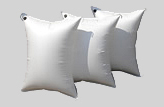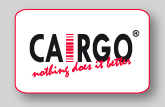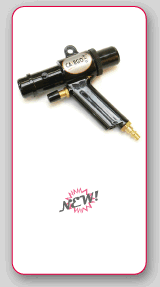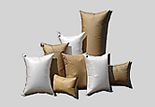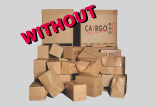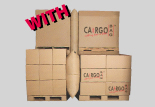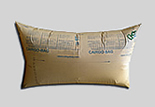Glossary - A
AAR
ABC classification
A.B.S.
Absorption
Acceptance of Goods
Accord Relatif aux Transports Internationaux de Denrées Périssables et aux Engins ....
A.C.E.P.
Acknowledgement of receipt
Act of God
Active Inventory
Actual demand
Actual Voyage Number
Ad Valorem
A.D.R.
Advance Arrangement
Advanced Charge
Advice Note
Aeroquip system
Aft
Agency Fee
Agent
Aggregate Inventory
A.I.M.
Air Commuter
Air Consignment Note
Air Mode containers
Air Way Bill
All Cargo Carrier
Allocation
Allotment
American Bureau of Shipping
Amidships
Apparel
Approved Continuous Examination Program
Apron
Area Code
Area of Repair
Area Off Hire Lease
Area Off Hire Sublease
Area On Hire Lease
Area On Hire Sublease
Arrival Notice
Articles Dangereux de Route
Assignment
Astern
Athwartships
A.T.P.
Authentication
Authorisation
Auto Container
Automatic Identification Manufacturers
Average
Average Adjusters
A.W.B.
AAR
Association of American Railroads
Circular no. 42-F or supplements thereto
General Rules Covering Loading of Carload Shipments of Commodities in Closed Cars requirements must be observed in all closed carloadings to insure safe transit of the rail car from origin to destination, thereby eliminating hazard to railroad operation.
Bureau of Explosives Tariffs
These tariffs contain Department of Transportation's Hazardous Materials Regulations and Specification for Shipping Containers and loading pamphlets. These must be complied with in loading and securement of explosives, flammables and other dangerous commodities.
Uniform Freight Classification Tariff
This tariff contains the source for proper article (lading) description and packaging rules and regulations, as well as some loading requirements for specific packages.
Circular no. 43
Review the Rules Coverning the Loading, Blocking and Bracing of Freight in Closed Trailers and Containers for TOFC/COFC Service for more exacting requirements covering loadings in trailers or containers.
Pamphlet no. 14
Purpose of this pamphlet is to relate basic good carloading procedures which have been developed through laboratory and field testing, engineering studies, and accumulated experience in rail transportation.
Many specific commodities such as steel, paper, plywood, machinery, canned goods, packaged grain mill products, etc. are governed in greater detail in individual carload commodity pamphlets. Specialized pamphlets will normally take precedence over these "general" rules.
Compliance with the Minimum Loading Requirements contained herein will insure conformance with Circular no. 42-F rules and provide adequate protection for lading from sources of damage in the normal railroad environment.
Notice:
Direct requests for inclusion of new bracing materials or equipment and/or new loading and bracing methods (or recognition by the carriers of acceptable alternatives) to the Freight Claim & Damage Prevention Division at the address shown on the cover of this pamphlet.
Pamphlet no. 14 A-General Information
Selection of Car
A-1) It is the reailroads' responsibility to supply cars which are clean, have sound roofs, sides and square end walls, smooth floors and snug fitting doors; any exception is cause for rejection. The shipper also has a responsibility to inspect cars at origin to see that they are suitable to carry lading safely to destination. It is important that cars be clean and free from protruding nails, brads, staples, temporary anchor plates, fragments of steel straps, old blocking, etc. Some projections of lining or anchor devices may be covered with sheets of currogated fibreboard taped in place. If car supplied is not suitable for loading and shipper elects to load this car rather than reject it, it is in the shipper's responsibility to upgrade the car.
General
A-2) Load, block or brace commodities tightly lengthwise and crosswise so as to eliminate all void spaces which are primary reasons for damage. Take up any void spaces remaining in a car by blocking, center gates, fillers, etc. secured in accordance with the methods outlined in this pamphlet and other pamphlets listed on back of cover page.
A-3) Load and secure lading so as to permit unloading from either side of rail car except when deminsions of individual units of freight prohibit.
A-4) Do not load any commodity of a contaminating nature in the same car with commodities liable to be contaminated thereby unless properly segregated and protected.
A-5) Stop-off Cars. Separately brace or block each individual consignment where necessary.
A-6) Stop-off Cars. Load consignments in reverse order to that in which they will be unloaded. This will facilitate unloading consignments in station order. Rule 27, Section 3 of Uniform Freight Classification states in part "Intermediate receiver of cars, vans, containers, trailers or other vehicle must reload in a level manner or brace or rebrace, if necessary to prevent damage, the remaining protion of lading destined to subsequent receiver."
A-7) Stop-off Cars. Place each shipment in the car so that the weight of individual shipment and the combined weight of the stop-off shipments is destributed in accordance with the requirements of "General Rules". In some instances, this may require the shipment for final destination to be stowed in both ends of the car. Restow at intermediate loading and unloading points, the freight remaining in the car, if necessary, to provide a proper distribution of weight or to provide a level through load for self-bracing when the commodity is such that other securements are not required.
A-8) Reinforce or renew bracing or gates protecting lading remaining in cars at intermediate unloading points and weakended by removal of adjoining freight. Securely fasten these items in position to safely carry the remaining consignments to destination. See Rule 27, section 3 of Uniform Freight Classification.
A-9) The ends of boxcars are designed to withstand a horizontal force induced by the lading as indicated below without exceeding 1/4" permanent deformation.
Table A, Boxcars
Nominal Capacity for Car in Tons
50 70 100
Total Force in Pounds on End
100,000 115,000 135,000
Percent of Total Force Uniformly Destributed
Top Half
35-45 35-45 35-45
Bottom Half
65-55 65-55 65-55
A-10) Wooden sheathing of boxcar is usually 13/16" nominal with a minimum of 25/32". End wall lining is 1½" thick with the top 5' having a thickness of 13/16".
Load planning
B-1) Inspect lading prior to loading of car. Do not load damaged lading.
B-2) Evenly distribute the weight of load from side-to-side and end-to-end in car and to a uniform height of lading insofar as lading permits. Place lighter shipping containers on top of heavier shipping containers with separating material used as neede between layers. Stow like size shipping containers in stacks and use divider material between stacks of different size shipping containers and shipping containers of different desities.
B-3) Stow shipping containers in the position such as to best utilize the shipping containers inherent strength.
B-4) Fill all lengthwise space with lading and with lading and filler material, or appropriately block and brace, unless a floating load method is used.
B-5) Plan load so that crosswise space is minimized without exceeding an aggregate of 18" unless appropriate additional bracing is used. Maintain vertical alignment to prvent crosswise movement.
B-6) In hand stowed shipments, use bonded block patterns for fibreboard shipping containers and key sack or brick wall loading patterns for bag loads.
B-7) Use doorway protection to prevent lading from contacting door and prevent lading falling from car when doors are opened. In plug door cars, doorway protection is not required except for large cylindrical items such as rolls of paper or drums.
B-8) Stow lading in a manner to prevent contact with doorpost.
B-9) Observe all recommended restaining capacities for special equipped cars.
B-10) Handle and stow all lading according to shippers' printed directions, such as "This Side Up", "Do Not Drop", "Clamp Here", etc.
B-11) Segregate irregular lading from remainder of lading by blocking and bracing.
B-12) Load longest dimension of narrow base items lengthwise of car. B-13) Apply temporary bracing in partly loaded or unloaded cars, which will be switched during the process of loading or unloading.
Unitizing
Unitizing shipping containers is an efficient means of handling, storing, loading, transporting and unloading which contribures to efficient utilization of carrier equipment. The following guidelines suggest ways to obtain the best stack stability in unit loads.
On wooden pallets
C-1) Stack individual pallet loads of shipping containers by Bonded Block or other interlocking methods.
C-2) Provide palletized units with unit-to-unit contact with minimum overhang of shipping containers on pallets.
C-3) No underhang on pallets is allowed lengthwise of car unless filler material is used or underhang otherwise compensated for, e.g. a method of filling underhang on pallets by using expanded corrugated honeycomb fibreboard with glued facings of single wall currogated fibreboard. Adhere to limitations.
C-4) Vertical alignment of shipping containers may be meintained by use of space fillers, currogated sleeves, corner protectors and strapping, shrink-wrapping the unit, spot-gluing or other methods proven by shipment.
C-5) Take up all lengthwise voids between pallets loads by use of load restraining devices or filler material.
C-6) Load as many units across the car as practical so long as units are loaded in a straight line lengthwise in the car. Use filler material to maintain vertical alignment and prevent crosswise movement of lading.
C-7) In double layer wooden pallet loads, have units equal in height to insure pallet contact both longitudinally and laterally. If this is not the case, then separate stacks of units with suitable divider sheets.
C-8) Use four-way entry allets in doorway area to facilitate unloading.
On Slip Sheets
C-9) Stack individual units of shipping containers by Bonded Block or other comparable unitizing methods.
C-10) Provide units with unit-to-unit contact lengthwise in car.
C-11) Maintain vertical alignment of shipping containers on slip sheets by use of space fillers, currogated sleeves, corner protectors and strapping, shrink-wrapping, stretch-wrapping, spot gluing or other methods proven by shipment.
C-12) Take up all lengthwise slack between units by use of load restraining devices, shipping containers or product, or other material.
C-13) Load as many units across the car as practical; so long as units are loaded in a straight line lengthwise in the car. Limit crosswise slack and maintain vertical alignment.
C-14) To facilitate unloading, double sheet doorway units so that a lip under each unit faces each door.
Inflatable Dunnage Material
K-1) Inflatable dunnage bags may be used to fill a lengthwise void in a boxcar. There are two types of inflatable dunnage; 1) Rubber inflatable dunnage bags which are reusable and, 2) Paper inflatable dunnage bags which are disposable and for use in one shipment only. Do not reuse paper bags.
Rubber Dunnage Bags (Reusable)
K-2) The rubber dunnage bag shall be fabricated from a coated base nylon cloth suitably compounded with heat vulcanizable black synthetic rubber uniformly applied to both sides of the fabric at the rate of not less than 22.60 ounces per square yard per side. The physical requirements of the coated base cloth are: 1) Tearing strength (tongue, pounds) of warp and of fill is 25 minimum; (2) abrasion taber (number of cycles per 0,3 gram weight loss) is 7,000 minimum.
K-3) The rubber dunnage bag shall not lose more than 0,25 pounds pressure in 24 hours when inflated to a pressure of 6 psig unrestrained, after an initial prestretch for one hour at a pressure of not less than 6 psig.
K-4) The rubber dunnage bag shall not burst or show any evidence of leakage when pressurized to not less than 12 psig restrained for 15 minutes at a rate of not more than 10 psig per minute.
K-5) Pressure test the bags for each use.
Paper Dunnage Bags (disposable-one shipment)
K-6) The paper disposable dunnage bag shall consist of six plies of paper and an inner bladder. Each ply of paper shall be 100 pound basis weight extensible type kraft paper and shall conform to the physical requirements of Table C, Rule 40 of the Uniform Freight Classification. The outside of the outer ply shall be uniformly coated with medium density polyethylene. The inner bladder shall be seamless and extruded from high density rubber-modified polyethylene and have a thickness of six mils (0.006") or be of equivalent construction meeting the parameters of Items K-7 and K-8.
K-7) The disposable paper dunnage bag shall not lose more than 0,5 pounds pressure in 14 days when inflated in an unrestrained state to a pressure of 3 psig.
K-8) The disposable paper dunnage bag shall not burst or show any evidence of leakage when pressurized to not less than 25 psig restrained for one minute in an 11" void.
Dunnage Bags - General
K-9) Follow manufacturers' instructions on care and installation of bags prior to use. Inflate bags with an approved inflator.
K-10) After inflation, check to see that dunnage bags are approximately the same size as the face of the load. In no instance shall the dunnage bag extend beyond the buffer material.
K-11) Use buffer material of sufficient strength to prevent its conforming to dunnage bag contour, te prevent chaffing and to prevent dunnage bag from crushing load at proper inflation pressure.
K-12) Use buffer material equal or slightly larger in size than face of lading. Have lading placed adjacent to bag(s) nearly equal in height on each side of bag.
K-13) Air pressure at inflation will vary from 2 psig to 8 psig dependent on the nature of lading.
K-14) Voide size after inflation shall be from 4" to 12". See applicable commodity publications for possible exceptions to this limitation.
K-15) Install bag(s) so that the bottom(s) will be a minimum of one inch above the floor after inflation. Also, protective material (fibreboard) can be applied between the bag and floor.
K-16) Hold down methods may be necessary to prevent bag(s) displacement from void area.
K-17) Use an air gauge to insure prescribed air pressure at inflation. Recheck air pressure one-half hour after inflation for leakage.
K-18) Use clean and dry air to fill dunnage bags.
K-19) Where types of ladings do not fill cross car width, use side fillers or other void filler material or methods of maintaining vertical alignment and load integrity.
K-20) Do not use bags in tandem. Dunnage bags may not be used to fill more than one lengthwise voide in a car.
K-21) Two bag systems are recommended unless a single bag system has been approved in specific commodity publications or other appropriate reglatory bodies (tariff approval).
K-22) Use of dunnage bag(s) does not eliminate the necessity of doorway protection.
Circular 43-A
Rules Governing the Loading, blocking and bracing of freight in closed trailers and containers for tofc/cofc service.
Introduction
These rueles which supersede Circular 43 as issued, march 1976, apply in both to trailers an containers regardless of shipping plan used. Reference to, or illustrations of, trailers in this publication includes both containers and trailers.
These ruled are designed for the benefit of all parties concerned. By adhering to the rules, both lading and equipment will be protected in the absence of unusual circumstances.
It must be understood that trailers or containers may move in a backwards or reverse direction for all or a portion of their journey. During it's journey, normal transportation forces will shift an unsecured load or cause lading to exert excessive pressure against the nose, rear doors or side walls. It is therefore, imperative that trailers or containers moving in rail service be loaded by the shipper (as defined in these rules is that party or his agent who is responsible for the physical loading and securement of the lading in the trailer or container), om strict compliance with the General Rules as contained in this publication.
If loading rules, illustrations or principles contained in this publication appear not to cover a specific shipment being tendered for TOFC/COFC movement, contact the origin carrier's LOSS and DAMAGE PREVENTION REPRESENTATIVE for assistance and/or instructions.
Loading rules and/or recommended practices, contained herein, apply to shipments originating in the USA, Canada and Mexico.
General Rules
1) Inspection and Selection of equipment
A) It is the equipment supplier's responsibility to furnish trailers which are clean, have sound roofs, sides and end walls, smooth floors and snug fitting doors. Any exception is cause for rejection. The shipper also has a responsibility to inspect the trailer at origin to see that it is suitable to carry lading safely to destination.
B) It is important that trailers be clean and fee from nails and other protruding objects.
C) If trailer supplied is not suitable for loading and shipper elects to load this trailer rather than reject it, it is the shipper's responsibility to properly prepare the trailer.
2) Planning of load
A) Plan loading to prevent damage to lading and equipment. Lading which is obviously unsuitable for movement in a trailer, as far as safety in handling and protection to lading and equipment are concerned, is not to be loaded.
B) Whenever there is any doubt as to procedures to follow contact your origin carrier's LOSS AND DAMAGE PREVENTION REPRESENTATIVE for instructions. New intermodal shippers or those shipping new commodities are to obtain advance instruction and assistance from origin carrier.
C) No commodity of a contaminating nature may be loaded in the same trailer with commodities liable to be contaminated thereby, unless properly segregated or protected.
D) Square the end of trailers, constructed with rounded or angled ends, when lading is loaded into this area which is not similarily countoured. This can be accomplished through construcion and use of fillers.
3) Maximum Weight
A) The load weight must not exceed the limit as stated on the manufacturer's plate. Combined weight of trailer and lading may not exceed 65,000 lbs. Combined weight of container and lading may not exceed 67,200 lbs.
B) Lading weight in trailers must be evenly distribured both crosswise and lengthwise and combined weight of lading and trailer must conform to all Federal, State and Local regulations and trasportation service requirements used at origin and to final destination.
C) Load trailers to ensure that proper weight distribution and position of lading is maintained while in transit. Fill voids or apply blocking and bracing as required.
D) Combined center of gravity (measured from top of rail) of car, trailer and load is not to exceed 98". E) Secure machinery or other equipment which has a high center of gravity to provent tipping.
4) Hazardous Materials
A) Loads of Hazardous Materials must conform to the regulations of the agency of authority of the countries within which the shipment will move. Some but not all regulations are: Department of Transportation Regulations as published in Bureau of Explosives Tariff 6000 series and supplements thereto and Canadian Transport Commission Tariff no. 5 and supplements thereto. Mexican shipments are governed by Bureau of Explosives Tariff 6000 series and supplements thereto.
B) Carrier is to be specifically informed on shipping orders as to the presence, type, characteristics and volume of all Hazardous Materials.
Loading and securement
A) Secure lading to prevent lengthwise movement. Trailer doors are not designed to fully restrain longitudinal movement of lading without resulting damage to equipment and lading. Trailer doors may not be used to restrain longitudinal movement of lading, unless specifically permitted by an AAR closed trailer loading publication.
B) Restrain lading from pushing through doors, nose or walls of trailers.
C) Load heavier items in lower layers and lighter items in upper layers.
D) Use suitable dividers between adjacent stacks of different sized containers, if the nature of the lading is such that damage will result from uneven contact of the layers.
E) Use lumber which is of sound material and free of defects which impair its strength or interferes with proper nailing.
F) Use adequate size and numbers of nails in the construction of dunnage and in the securement of same within the trailer.
G) Do not nail into side walls of trailers. No toenailing, except as illustrated in approved loading figures, is permitted.
H) When strapping is used for load securement, use strapping of sufficient strength and amount and properly applied as to hold load secure from crosswise or lengthwise movement.
I) Apply plastic sheeting or other suitable material to the top and rear of lading that is susceptible to damage from moisture, water, dust, etc.
6) Special Equipment
A) Use special equipment in trailers so equipped. Lading anchor devices are commercially available which can be used in securing strapping or other materials into belt rails or vertical logistics posts.
Circular 43-C
Rules Governing the loading, blocking and bracing of freight in closed trailers and containers for TOFC/COFC service.
Introduction
These rules which supersede Circular 43-B as issued, May 1992, apply both to trailers and containers regardless of shipping plan used. Reference to, or illustrations of, thailers in this publication includes both containers and trailers.
These rules are designed for the benefit of all parties concerned. By adhering to the rules, both lading and equipment will be protected in the absence of unusual circumstances.
It must be understood that trailers or containers may move in a backwards or reverse direction for all or a portion of their journey. During its journey, normal transportation forces will shift an unsecured load or cause lading to exert excessive pressure against the nose, rear doors or side walls. It is therefore, imperative that trailers or containers moving in rail service be loaded by the shipper in strict compliance with the General Rules as contained in this production. Shipper is defined in these rules as that party or his agent who is responsible for the physical loading and securement of the lading in the trailer or container.
If loading rules, illustrations or principles contained in this publication appear not to cover a specific shipment being tendered for TOFC/COFC movement, contact the origin carrier's LOSS AND DAMAGE PREVENTION REPRESENTATIVE for assistance and/or instructions.
Loading rules contained herein, apply to shipments transported in the USA, Canada and Mexico.
General information and approved loading methods for TOFC/COFC shipments are published in sections III and IV of this Intermodal Loading Guide.
Loading
A) Load Planning
A-1) Inspect lading prior to loading of trailer. Do not load damaged lading.
A-2) Evenly distribute the weight of load from side-to-side and end-to-end in trailer and to a uniform height insofar as lading permits. Place lighter shipping containers on top of heavier shipping containers which separating material used as neede between layers. Load like size shipping containers in stacks and use divider material between stacks of different size or type of shipping containers and shipping containers of different densities.
A-3) Place shipping containers in the position to best utilize the shipping containers'inherent strength.
A-4) Fill all lengthwise space with lading or with lading and filler material, or appropriately block and brace, unless loaded to a specific method.
A-5) Plan load so that crosswise void space is minimized. Use appropriate bracing or filler material to maintain vertical alignment and prevent crosswise movement. A four-unit pinwheel pattern may be effective in reducing voids.
A-6) In manually loaded shipments, use bonded block patterns for fibreboard shipping containers and key-sack or brick-wall loading patterns for bag loads. Load cylindircal shaped items, such as drums, pails or rolls of paper in a recessed or in-line loading pattern.
A-7) Never exceed marked or recommended restraining capacities for special interior fixtures.
A-8) Handle and load all freight according to shippers'printed directions, such as "This Side Up", "Do Not Drop", "Clamp Here", etc.
A-9) Segregate irregular lading from remainder of lading using blocking and bracing or sparators and dividers.
A-10) Load longest dimension of narrow base items lengthwise of trailer.
A-11) No commodity of a contaminating nature may be loaded in the same trailer with commodities liable to be contaminated thereby, unless properly segregated or protected.
A-12) Use a trailer liner or apply plastic sheeting to the top and rear of lading that is susceptible to damage from moisture, water, dust, etc.
A-13) Stop-off Trailers - Load consignments in reverse order to that in which they will be unloaded. Separately block or brace each individual consignment where necessary. Intermediate receivers are to reload in a level manner or brace or rebrace, if necessary, the remaining protion of the lading destined to subsequent receiver(s).
ABC classification
A classification of a group of products into three categories for the purpose of stock control and planning. The criterion can be for example the demand, the consumption value, production value or turnover value per period. The categories are designated A, B and C:
A) A small group of products which represents a large part of the total consumption and/or production value or turnover value.
B) An intermediate group to which less attention is paid.
C) A large group of products which represents only a small part of the total consumption and/or production value or turnover value. Relatively speaking, this categorie receives the least attention.
A.B.S.
See American Bureau of Shipping.
Absorption
Acceptance by the carrier of a portion of a joint rate or charge which is less than the amount which it would receive for the service in the absence of such joint rate or charge (aircargo).
Acceptance of Goods
The process of receiving a consignment from a consignor, usually against the issue of a receipt. As from this moment and on this place the carrier's responsibility for the consignment begins.
Accord Relatif aux Transports Internationaux de Denrées Périssables et aux Engins Spéciaux à Utiliser pour ces Transports
Abbreviation: A.T.P.
Agreement on the international carriage of perishable food-stuffs and on the special equipment to be used for such carriage.
A.C.E.P.
See Approved Continuous Examination Program.
Acknowledgement of receipt
A notification relating to the receipt of e.g. goods, messages and documents.
Act of God
Accidents of a nature beyond human control such as flood, lightning or hurricane, usually resulting in "force majeure".
Active Inventory
Covers raw material, work in progress, finished products which will be used or sold within a given period without extra cost or loss. This term does not cover the so-called reserve inventory.
Actual demand
Customer orders and often also the allocation of items, ingredients and/or raw materials to production or distribution.
Actual Voyage Number
A code for identification purposes of the voyage and vessel which actually transports the container.
Ad Valorem
In proportion to the value: a phrase applied to certain freight or customs duties levied on goods, property, etc. set as a percentage of their value.
A.D.R.
See Articles Dangereux de Route.
Advance Arrangement
An agreement between the shipper and the carrier, concerning contacts between those parties prior to tendering the consignment (aircargo).
Advanced Charge
A charge paid by a carrier to an agent or to another carrier, which the delivering carrier then collects from the consignee. Such charges are usually for agents'forwarding fees and incidental expenses paid out of pocket for accoutn of the shipment by an agent or other carrier (aircargo).
Advice Note
A written piece of information e.g. about the status of the goods.
Aeroquip system
Special accessories in a container consisting of among others the attachment rails on the inside walls to provide facilities for lashing and separation of the cargo.
Aft
At, near or towards the stern or rear of a vessel or an aircraft.
Agency Fee
Fee payable by a shipowner or ship operator to a port agent.
Agent
1) A person or organization authorized to act for or on behalf of another person or organization.
2) In shipping, an agent is a corporate body with which Nedlloyd has an agreement to perform particular funcions on behalf of Nedlloyd at an agreed payment. An agent is either a part of the Nedlloyd organization or an independent body. The following functions and responsibilities may apply to the activities of an agent:
I) Sales:
a) Sales Marketing, acquisition of cargo, issuing freight, quotations, concluding contracts in coordination with Nedlloyd. Basically the agent is the first point of entry into the Nedlloyd organisation for a shipper.
b) Bookings: booking of cargo in accordance with allotments assigned to the agent for a certain voyage by Nedlloyd.
c) Documentation: Responsible for timeliness and correctness of all documentation required, regarding the carriage of cargo.
d) Handling: Taking care of all procedures connected with physical handling of cargo.
e) Equipment control: Managing of all equipment stock in a particular area.
f) Husbanding: Handling non cargo related operations of a vessel as instructed by the master, owner or charterer.
g) Collecting: Authorised to collect freight and charges on behalf of Nedlloyd.
Aggregate Inventory
The inventory for any group of items or products, involving more than one stockkeeping unit.
A.I.M.
See Automatic Identification Manufacturers.
Air Commuter
A class of airline that generally serves smaller market cities with a small aircraft.
Air Consignment Note
See Air Way Bill.
Air Mode containers
Note: Terminology and definitions applicable to air mode containers are under study. Containers of this type have typecodes 90 to 99.
Air Way Bill
Abbreviation: A.W.B. A document made out by or on behalf of the carrier(s) confirming receipt of the goods by the carrier and evidencing the contract between the shipper and the carrier(s) for the carriage of goods as described therin. Synonym: Air Consignment Note.
All Cargo Carrier
An air carrier transporting aircargo only.
Allocation
The process of assigning activities, costs or facilities to certain organizational units.
Allotment
A share of the capacity of a means of transport assigned to a certain party, e.g. a carrier or an agent, for the purpose of the booking of cargo for a specific voyage.
American Bureau of Shipping
Abbreviation: A.B.S.
American classification society which has established rules and regulations for the classification of seagoing vessels and other equipment.
Amidships
At or in the middle of a vessel.
Apparel
A vessel's outfit, such as rigging, anchor and life boats.
Approved Continuous Examination Program
Abbreviation: A.C.E.P.
An agreement between the owners of the equipment and the classification society to allow continuous examination of the equipment (e.g. containers).
Apron
See platform.
Area Code
A code for the area where a container is situated.
Area of Repair
Geographical area where a container is under repair.
Area Off Hire Lease
Geographical area where a leased container becomes off hire.
Area Off Hire Sublease
Geographical area where a subleased container becomes off hire.
Area On Hire Lease
Geographical area where a leased container becomes on hire.
Area On Hire Sublease
Geographical area where a subleased container becomes on hire.
Arrival Notice
A notice sent by a carrier to a nominated notify party advising of the arrival of a certain shipment.
Articles Dangereux de Route
Abbreviation: A.D.R.
A European agreement concerning the international carriage of dangerous goods by road.
Assignment
The transfer of certain rights from one party to another.
Astern
1) Behind a vessel or an aircraft.
2) Backward; i a reverse direction.
Athwartships
Across the vessel, that is, from side to side. Said of cargo stowed in this way, as opposed to lenthwise.
A.T.P.
Authentication
Proof by means of a signature or otherwise that a certain document or cerntain data is of undisputed origin and genuine.
Authorisation
The commission to a certain person or body can be authorized e.g. to issue Bills of Lading or to collect freight.
Auto Container
Container equippped for the transportation of vehicles.
Automatic Identification Manufacturers
Abbreviation: A.I.M.
International organisation of trade association involved or interested in automatic identification.
Average
1) Apportionment of the loss of a vessel, cargo or freight through unavoidable accident or through unintentional damage to the vessel or sacrifice of cargo, among the owners or insurers.
2) In marine insurance: a loss or damage to or in respect of goods or equipment.
3) The numerical result obtained by devideing the sum of two or more quantities by the number of quantities.
Average Adjusters
Average adjusters are entrusted with the task of apportioning the loss and expenditure over the parties interested in the maritime venture and to determine which expenses are to be regarded as particular average or general average.
A.W.B.
See Air Way Bill.

